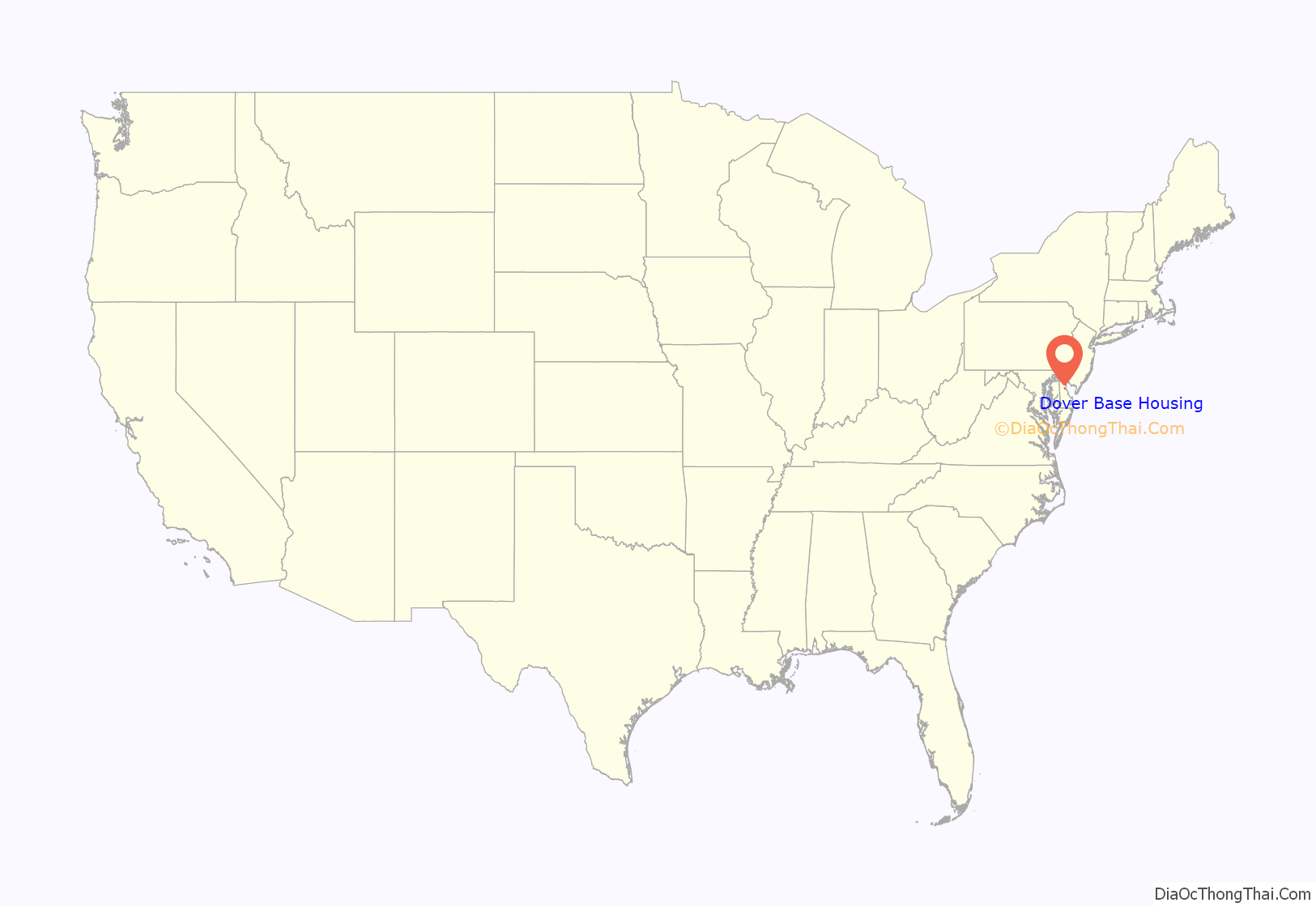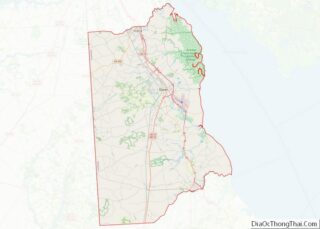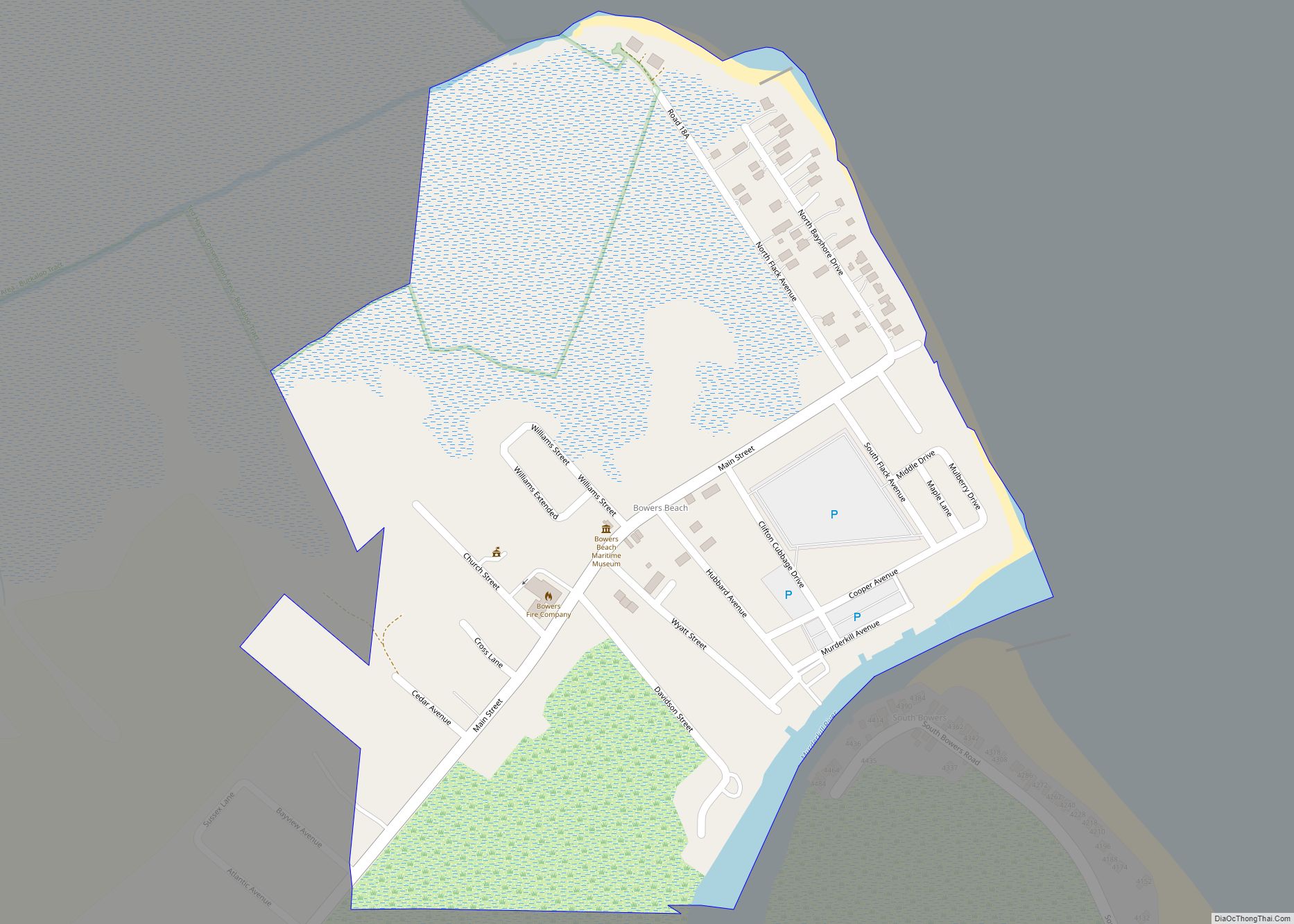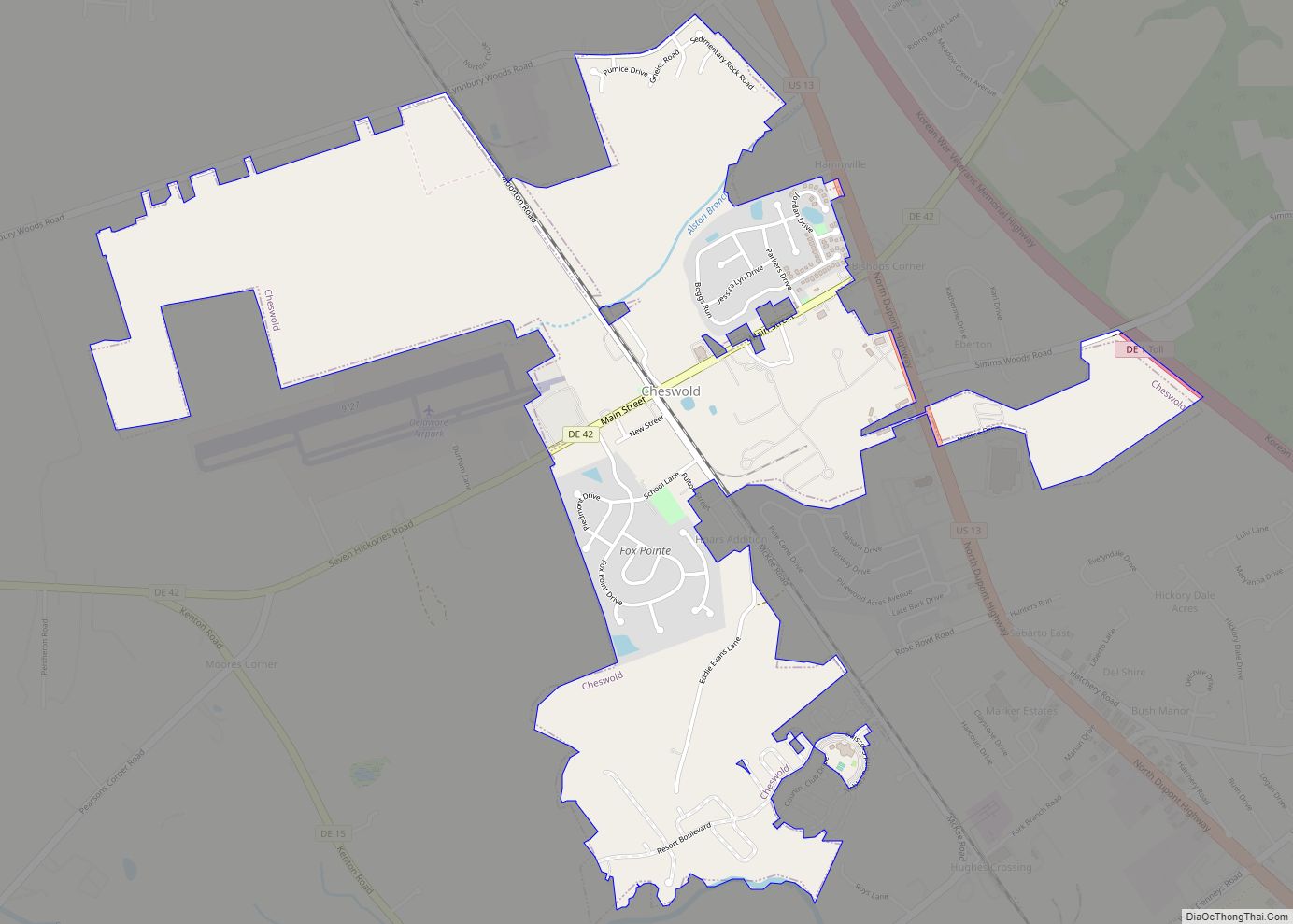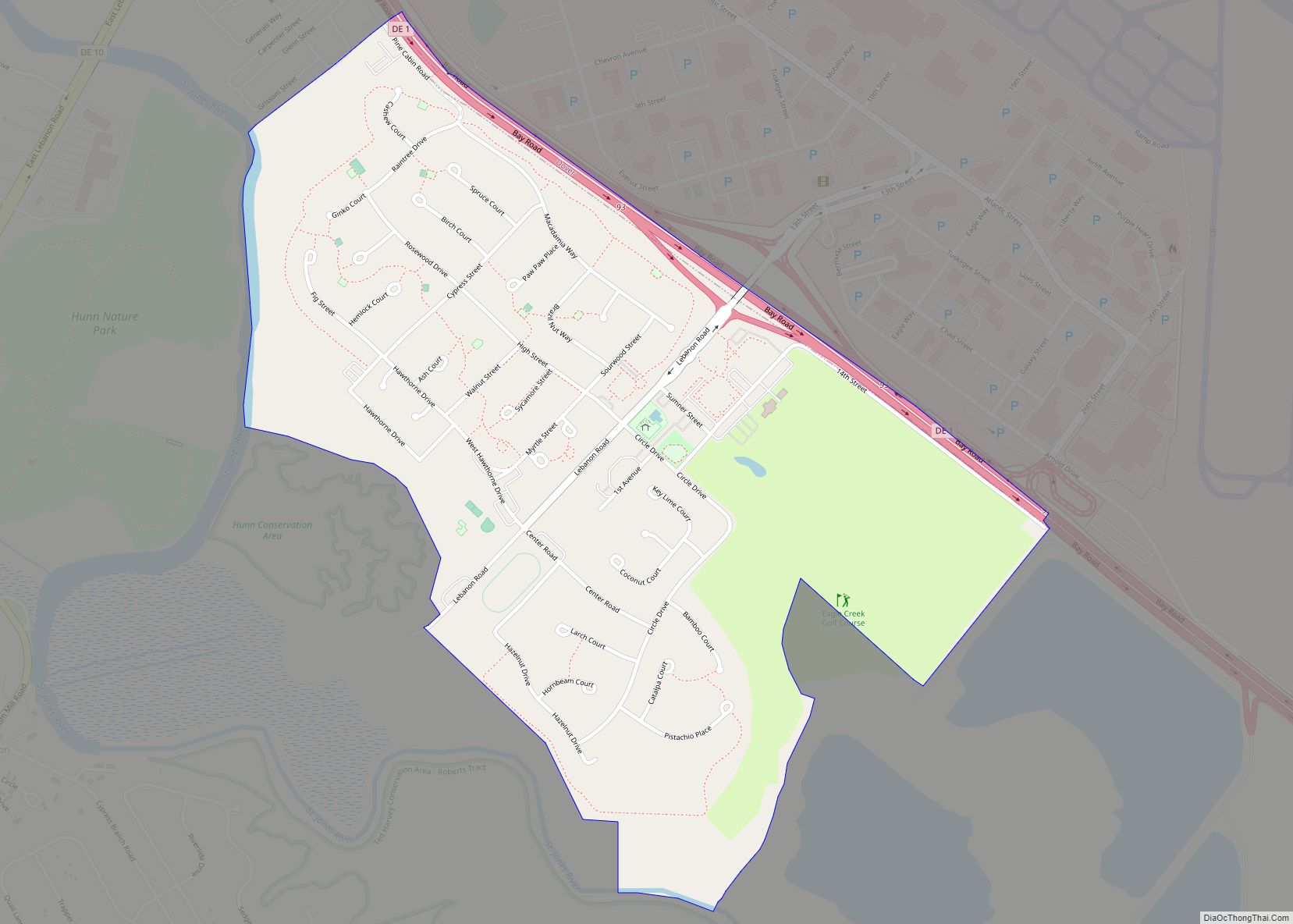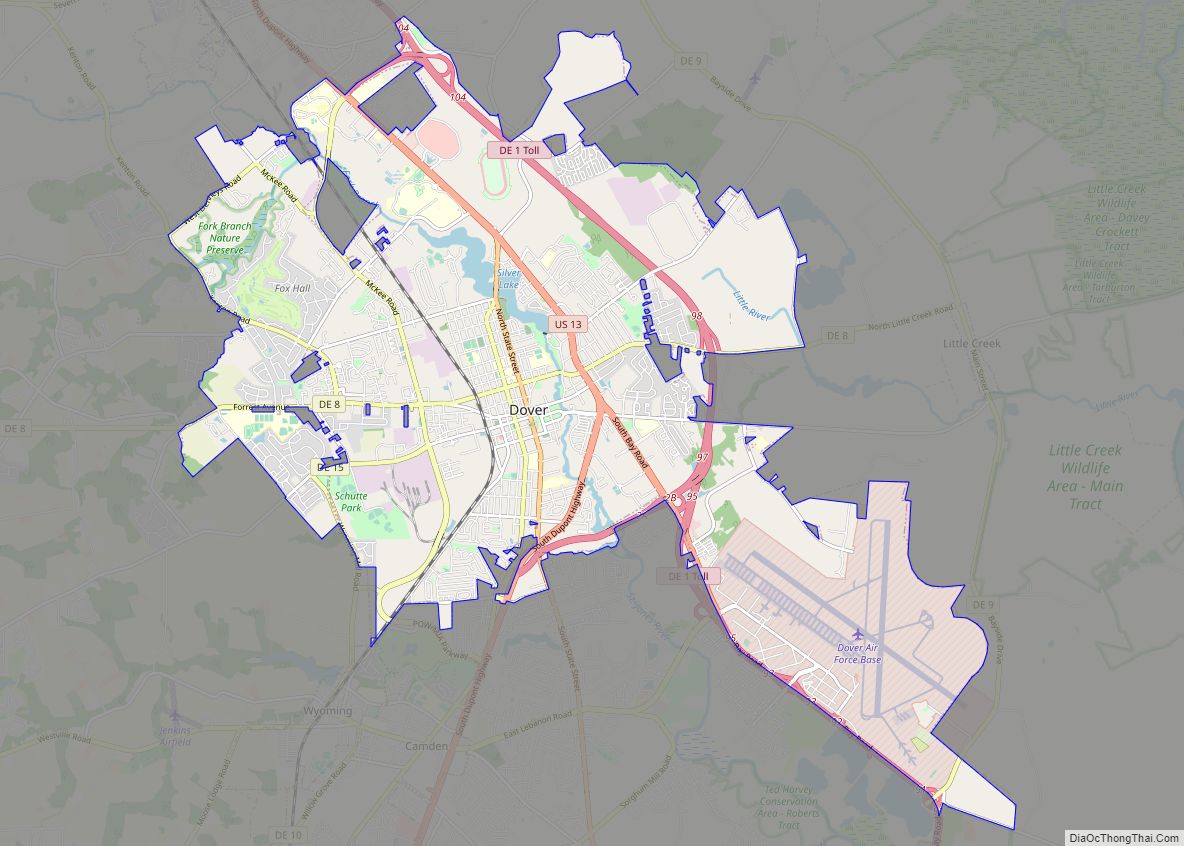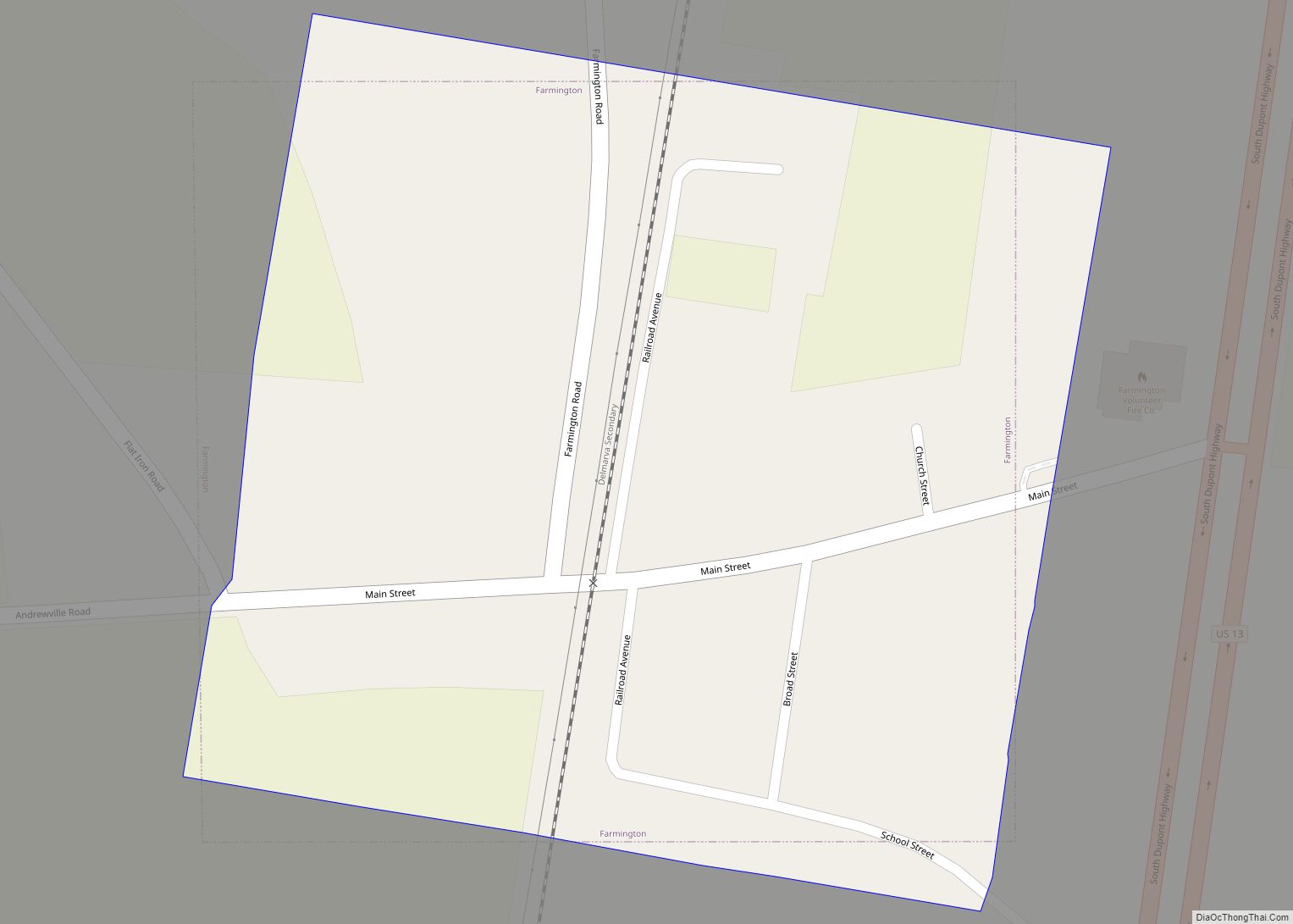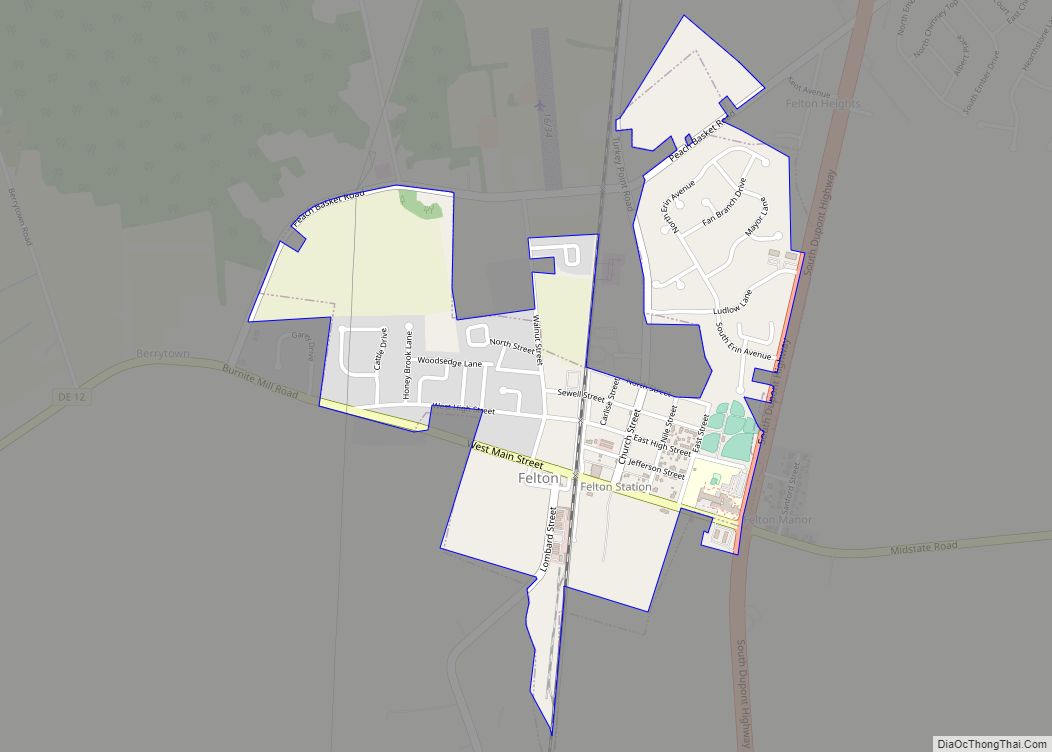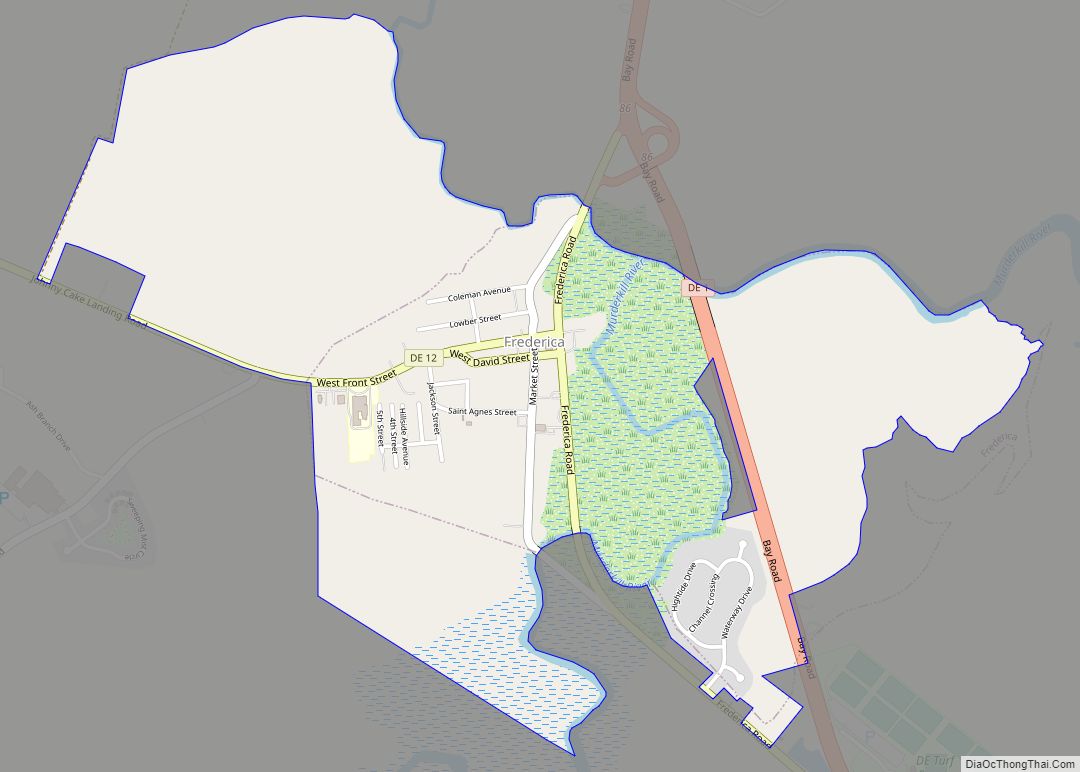Dover Air Force Base or Dover AFB (IATA: DOV, ICAO: KDOV, FAA LID: DOV) is a United States Air Force (USAF) base under the operational control of Air Mobility Command (AMC), located 2 miles (3.2 km) southeast of the city of Dover, Delaware. The 436th Airlift Wing is the host wing and runs the busiest and largest air freight terminal in the Department of Defense.
| Name: | Dover Base Housing CDP |
|---|---|
| LSAD Code: | 57 |
| LSAD Description: | CDP (suffix) |
| State: | Delaware |
| County: | Kent County |
| Elevation: | 8.8 metres (29 ft) |
| FIPS code: | 1021387 |
| Website: | www.dover.af.mil/ |
Online Interactive Map
Click on ![]() to view map in "full screen" mode.
to view map in "full screen" mode.
Dover Base Housing location map. Where is Dover Base Housing CDP?
History
Construction of Municipal Airport, Dover Airdrome began in March 1941 and the facility was opened on December 17, 1941. It was converted to a U.S. Army Air Corps airfield just weeks after the December 7, 1941, attack on Pearl Harbor. It was renamed Dover Army Airbase on April 8, 1943; *Dover Subbase on June 6, 1943, and Dover Army Airfield on February 2, 1944. With the establishment of the United States Air Force (USAF) on September 18, 1947, the facility was renamed Dover Air Force Base on January 13, 1948.
* Was a subbase of Camp Springs AAF, Maryland, June 6, 1943 – April 15, 1944.
World War II
The origins of Dover Air Force Base begin in March 1941 during World War II when the United States Army Air Corps (USAAC) indicated a need for the airfield as a training airfield and assumed jurisdiction over the municipal airport at Dover, Delaware.
Once the airport came under military control an immediate construction program began to turn the civil airport into a military airfield. Construction involved runways and airplane hangars, with three concrete runways, several taxiways and a large parking apron and a control tower. Several large hangars were also constructed. Buildings were ultimately utilitarian and quickly assembled. Most base buildings, not meant for long-term use, were constructed of temporary or semi-permanent materials. Although some hangars had steel frames and the occasional brick or tile brick building could be seen, most support buildings sat on concrete foundations but were of frame construction clad in little more than plywood and tarpaper. Initially under USAAC, the name of the facility was Municipal Airport, Dover Airdrome and the airfield opened on 17 December 1941. The airfield was assigned to the First Air Force.
On 20 December the first military unit arrived at Dover’s new airfield: the 112th Observation Squadron of the Ohio National Guard which flew anti-submarine patrols off the Delaware Coast. In early 1942 three B-25 Mitchell bomber squadrons arrived with the 45th Bombardment Group from I Bomber Command, later part of Army Air Forces Antisubmarine Command, assumed the anti-submarine mission.
On 8 April 1943, the name of the airfield was changed to Dover Army Air Base. The antisubmarine mission ended on 6 June and construction crews moved back to the base for a major upgrading project that lengthened the main runway to 7,000 feet. During the construction period and continuing into June 1944, Dover AAB became a sub-base of Camp Springs Army Airfield, Maryland.
Full operational capability was restored to Dover in September, and seven P-47 Thunderbolt squadrons arrived for training in preparation for eventual involvement in the European Theater. The 83d Fighter Group was assigned to Dover as the Operational Training Unit. The 83d was redesignated the 125th Base Unit on 10 April 1944 with little change in its mission. It was further redesignated as the 125th Army Air Force base Unit on 15 September 1944.
In 1944 the Air Technical Service Command chose Dover as a site to engineer, develop, and conduct classified air-launched rocket tests. The information collected during these experiments resulted in the effective deployment of air-to-surface rockets in both the European and Pacific combat theaters.
On 1 September 1946 as a result of the drawdown of United States forces after the war, Dover Army Airfield, was placed on temporary inactive status. A small housekeeping unit, the 4404th Base Standby Squadron, remained on the airfield for care and maintenance of the facility.
Cold War and Vietnam
Dover Airfield was reactivated on 1 August 1950 as a result of the Korean War and the expansion of the USAF in response to the Soviet threat in the Cold War. On February 1, 1951, the 148th Fighter Interceptor Squadron of the Pennsylvania Air National Guard arrived with P-51 Mustang fighter aircraft. During the 1950s problems developed with many of the facilities in Dover, which had been hastily constructed to support its World War II mission. As a result, a massive Civil Engineering project was undertaken to modernize the base.
On April 1, 1952, Dover was transferred to the Military Air Transport Service (MATS) and became home to 1607th Air Transport Wing (Heavy). A full function hospital was completed in 1958 and base housing was expanded to handle 1,200 families in 1961. On January 1, 1966, the Military Air Transport Service was redesignated the Military Airlift Command (MAC). Along with the reorganization, the 1607th was discontinued and the 436th Military Airlift Wing (436 MAW) activated and assumed the mission at Dover. The 436 MAW started replacing C-141 Starlifters and C-133 Cargomasters with the new C-5 Galaxy in 1971. Two years later Dover became the first all C-5 equipped wing in the USAF, trading the last of its C-141 to Charleston AFB, South Carolina.
During the Vietnam War, more than 20,000 dead American soldiers were brought back to the United States via Dover. The Vietnam War dead comprise over 90% of all the remains processed at Dover before 1988.
When the Yom Kippur War broke out between Israel and the combined forces of Egypt and Syria on October 13, 1973 the 436 MAW responded with a 32-day airlift that delivered 22,305 tons of munitions and military equipment to Israel. The 436 MAW also assisted in the evacuation of Americans from Iran on December 9, 1978, following the Islamic Revolution. That year, Dover AFB was also used to store hundreds of bodies from the mass murder and suicide of the Jonestown community in Guyana.
Some of the more memorable flights during the post-war period included the airdrop and test firing of a Minuteman I intercontinental ballistic missile and the delivery of a 40-ton superconducting magnet to Moscow during the Cold War, for which the crew received the Mackay Trophy.
After the Space Shuttle Challenger disaster, the remains of the seven astronauts were transferred to Dover AFB. It is one of only seven airports in the country that served as launch abort facilities for the Space Shuttle.
In March 1989, C-5s from Dover delivered special equipment used to clean up the Exxon Valdez oil spill in Prince William Sound, Alaska. On June 7, 1989, while attending the Airlift Rodeo, a 436 MAW C-5 set a world record when it airdropped 190,346 pounds and 73 paratroopers. In October 1983, the wing flew 24 missions in support of Operation Urgent Fury, the Grenada rescue operation and later flew 16 missions to support Operation Just Cause, the invasion of Panama, in December 1989 – January 1990.
During Desert Shield, the wing flew approximately 17,000 flying hours and airlifted a total of 131,275 tons of cargo in support of combat operations after the Iraqi invasion of Kuwait.
Southern Air Transport cargo airline leased a hangar at the south east end of the base in the 1980s, during Iran Contra.
Modern era
In 1992, with the disestablishment of Military Airlift Command, Dover AFB was transferred to the newly established Air Mobility Command (AMC) and the 436 MAW and 512 MAW (Associate) were redesignated as the 436th Airlift Wing (436 AW) and the 512th Airlift Wing (512 AW), respectively. Dover also served as a major port of entry and exit for the conflicts in the Balkans and Somalia during the latter half of the 1990s.
Following the attacks of September 11, 2001, the 436 AW and 512 AW became major participants in Operation Enduring Freedom and Operation Iraqi Freedom. An aircrew from Dover’s 3rd Airlift Squadron landed the first C-5 in Iraq in late 2003 when they landed at Baghdad International Airport and the two wings continue to support operations in the region.
Also following September 11, 2001, U.S. Army mortuary specialists organized support for Pentagon recovery efforts out of the base. This effort evolved into the Joint Personal Effects Depot, which supports recovery and redistribution of the personal effects of wounded and killed personnel from all arms of the military. In 2003, the Depot was transferred to Aberdeen Proving Ground in Maryland. Dover AFB is also where service members, from all six branches of service, killed in combat are repatriated. Their remains are processed, inspected for unexploded ordnance, cleaned, and prepared for burial before being escorted to the point of interment decided by the family. The Depot returned to Dover in 2011, when in April a new US$14 million custom-built facility officially opened.
On April 3, 2006, a C-5 Galaxy crashed short of a runway, skidding into a farm field. There were no fatalities.
By 2008, the air traffic tower serving the airfield, built in 1955, was the oldest such tower in use in the USAF. In 2009 the base received a new 128-foot tall tower, overlapping the original 103-foot one which was donated to the Air Mobility Command Museum, accessible to visitors.
Dover AFB is the first air force base to receive the new C-5M “Super Galaxy”, receiving the aircraft on February 9, 2009 (named “The Spirit of Global Reach”).
On February 2, 2015 the 9,600 foot runway 01-19 was closed for repairs. The runway was re-opened for operation on September 23, 2016. During the repair, the 12,900 foot runway 14–32 was temporarily cut in half so that the intersection of the two runways could be repaired. C-17 Globemasters could land on either half of runway 14–32.
Dover Base Housing Road Map
Dover Base Housing city Satellite Map
Geography
The base is treated as a census-designated place named “Dover Base Housing.” It is part of the Dover, Delaware Metropolitan Statistical Area. Dover Base Housing had a population of 3,450 at the 2010 census. According to the United States Census Bureau, Dover Base Housing has a total area of 0.7 square miles (1.7 km), all land.
Dover Base Housing consists of a development called Eagle Heights Family Housing, which is made up of 980 homes in single-family, duplex, triplex, and fourplex configurations. The development features a community center, multiple neighborhood centers, picnic areas, fitness center, and golf course. Eagle Heights Family Housing contains a total of 19,500 feet (5,900 m) of greenbelt paths for walking, jogging, and biking. Students in the development attend public schools in the Caesar Rodney School District.
Since 1997, the base has been served by three highway exits with Delaware Route 1, allowing quick access to Dover and to southern Delaware from the complex. Dover AFB provides almost $470 million a year in revenue to the city of Dover, making it the third largest industry in Delaware.
See also
Map of Delaware State and its subdivision: Map of other states:- Alabama
- Alaska
- Arizona
- Arkansas
- California
- Colorado
- Connecticut
- Delaware
- District of Columbia
- Florida
- Georgia
- Hawaii
- Idaho
- Illinois
- Indiana
- Iowa
- Kansas
- Kentucky
- Louisiana
- Maine
- Maryland
- Massachusetts
- Michigan
- Minnesota
- Mississippi
- Missouri
- Montana
- Nebraska
- Nevada
- New Hampshire
- New Jersey
- New Mexico
- New York
- North Carolina
- North Dakota
- Ohio
- Oklahoma
- Oregon
- Pennsylvania
- Rhode Island
- South Carolina
- South Dakota
- Tennessee
- Texas
- Utah
- Vermont
- Virginia
- Washington
- West Virginia
- Wisconsin
- Wyoming
